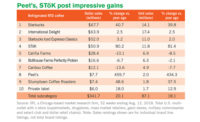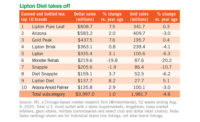The future looks bright for dairy processors that also produce ready-to-drink (RTD) coffee and/or tea. Such products mesh well with current consumer demand for beverages that go beyond simple hydration.
RTD coffee on fire
The daily “cup of Joe” has taken on a new meaning as consumers increasingly are trending toward crafted and tasteful, yet highly caffeinated forms of coffee. RTD coffees, including cold-brew varieties, seem to be appealing to consumers who wish to stay energized in their day-to-day lives.
The extensive growth of RTD coffee can be attributed to several factors, experts note. For example, the shift away from carbonated soft drinks partially has boosted the performance of the coffee subcategory, notes Matthew Barry, senior beverage analyst for Chicago-based Euromonitor International, in a recent Beverage Industry issue.
“The decline of carbonated soft drinks and other high-sugar products has created a real opportunity for emergent soft drink categories,” he explains. “RTD coffee has done a good job in moving into some of these occasions.
“What’s interesting about that is that many of these occasions were previously not times when people were drinking coffee,” he continues. “The growth of RTD represents an absolute gain for the category in a way that pods didn’t since they were generally just displacing other brewing methods.”
Another contributing factor to RTD coffee’s high growth is cold-brew coffee. Roger Dilworth, senior editor at New York-based Beverage Marketing Corp., highlights the success of the cold-brew craze.
“[Cold-brew coffees] have enabled entrepreneurs to enter the hard-to-crack RTD coffee space, as well as gives established players a platform with which to diversify,” he notes in a recent Beverage Industry issue. “It could be argued that RTD coffee would have decelerating growth by now if not for the emergence of the cold-brew sub-segment,” he adds.
RTD tea benefiting from a health halo
The number of Americans who drink tea today exceeds 158 million, which is half the U.S. population, the Cleveland, Ohio-based Academy of Nutrition and Dietetics shares in Beverage Industry’s June 2019 issue. And refrigerated RTD teas account for much of that consumption.
“Overall growth of tea has been driven by convenient RTD teas, particularly refrigerated varieties (including kombucha), that have a more healthy aura than shelf-stable products,” states Rockville, Md.-based Packaged Facts in its “U.S. Beverage Market Outlook 2019” report. “Tea has also benefited from consumers’ ongoing recognition of its healthy properties, especially compared to sugary carbonated beverages.”
In Beverage Industry’s June 2019 issue, Anna Amir, lead industry analyst for Los Angeles-based IBISWorld, notes that both RTD tea and tea overall have benefited from a growing emphasis on healthy living, shifting consumer dietary patterns toward healthier beverages.
A prosperous economy enabling consumers to trade up to more premium and higher-price-point varieties is particularly impacting RTD beverages, as consumers are more likely to purchase new beverages or new varieties as per-capita disposable income increases, Amir adds.
Packaged Facts’ report also pinpoints RTD teas as a segment benefiting from the functional foods and beverages trend.
“While functionality abounds when it comes to loose-leaf teas on the market, the same now can be said for the RTD category,” the report states. “Green tea itself is considered by many as a superfood, as research shows it can improve brain function, prevent cancer and even aid in weight loss.”
In its September 2018 “Tea and RTD Tea — US” report, global market research firm Mintel predicts a bright future for the tea category, including the RTD segment. The category also will be aided by the exploration of cannabis-infused teas, as well as the rise of refrigerated kombucha teas and sparkling teas, it states.
To better position themselves in the market, Amir advises RTD producers to find new ways to distinguish their brands from the competition, whether it be through advertising, flavors or entirely new products.
Note: This article was condensed from articles that originally appeared in the July 2019 issue of Beverage Industry, a sister publication of Dairy Foods.



